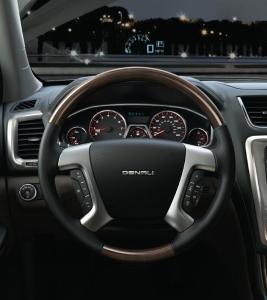 We can all agree that airplanes and cars are amazing examples of modern technology. Put them together and you get a combination of awesomeness that no mere mortal can truly comprehend. In fact, how many of us have dreamed of one day firing up our wheels, shedding the road, and taking to the sky? A good deal, no doubt. But while we’ll most likely have to file that dream under pure science fiction for now — we won’t be piloting our Pilots to work anytime soon, sorry — General Motors has added a nifty new piece of technology that they say was “born out of aerospace research” and could very well be a step in that fun-flying direction.
We can all agree that airplanes and cars are amazing examples of modern technology. Put them together and you get a combination of awesomeness that no mere mortal can truly comprehend. In fact, how many of us have dreamed of one day firing up our wheels, shedding the road, and taking to the sky? A good deal, no doubt. But while we’ll most likely have to file that dream under pure science fiction for now — we won’t be piloting our Pilots to work anytime soon, sorry — General Motors has added a nifty new piece of technology that they say was “born out of aerospace research” and could very well be a step in that fun-flying direction.
So what is it this technology exactly? Well, it looks like General Motors is adding a new futuristic heads-up display (HUD) — similar to what’s found in Fighter Jets – as part of a technology package upgrade in the 2012 Acadia and the upcoming redesigned 2013 model.
With the new HUD, drivers will be able to access information they typically would via the dashboard such as speed and tachometer readings, outside temperature, and turn signal activation, through a projected image onto the windshield.
GM explains that the new system utilizes two mirrors that reflect a digital image off of the windshield making it appear as if it were floating in front of your eyes.
It all sounds really cool, but we can’t help but wonder if the HUD would actually prove distracting, given the amount of images and numbers floating around in your field of vision while driving. As of now, while you drive, you’re line of sight is generally transfixed in front of you (or at least it should be, right texters?). Projecting images and gauges underneath or in your direct field of vision seems like a good way to clutter up your already bug-splattered windshield.
Evidently, these questions and concerns have already cropped up during the research process, with the implementation of the HUD display proving more difficult than simply projecting the information onto the windshield.
“The technology is useful but challenging,” says Wen Wu, a Carnegie Mellon University School of Computer Science researcher. “The key issue is deciding what to display, where to display, when to display, and how to display — adding that the naturally curved shape of a windshield greatly affects how to display the various information panels correctly.
“With these devices, the main benefit is seeing important information without the distraction of looking down,” explained Wu.
Despite our concerns, any sort of HUD display — or similar technological innovation inside our cars — is by and large a good thing. Hopefully we’ll see this technology continue to spread into more and more vehicles.


